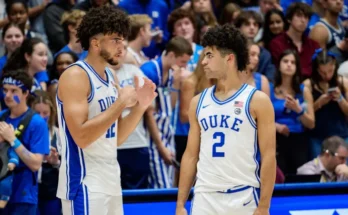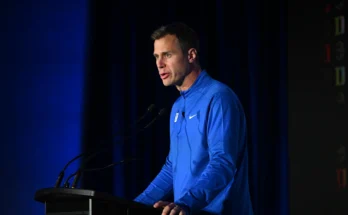Experts’ new College Football Playoff and bowl projections see Clemson Tigers falling
College football season is only a few weeks in, but the winds of projection are already shifting, and few programs have felt that change as sharply as the Clemson Tigers. Once considered a staple of the College Football Playoff conversation, Clemson now finds itself slipping in the eyes of national experts. The latest bowl projections and playoff forecasts show the Tigers tumbling out of semifinal contention, sparking conversation about whether the program has finally lost its grip on the elite tier it once dominated.
For years, Clemson was synonymous with the College Football Playoff. Under Dabo Swinney, the Tigers turned dominance in the ACC into a springboard for national glory, winning two national championships and producing an assembly line of NFL talent. Quarterbacks like Deshaun Watson and Trevor Lawrence became household names, while Clemson’s defensive lines and skill players helped forge one of the most balanced programs in the country. From 2015 through 2020, it felt like a given that the Tigers would be in the playoff discussion every December.
But the past few seasons have chipped away at that aura of inevitability. Offensive struggles, inconsistency at quarterback, and stiffening competition across the nation have raised questions about Clemson’s trajectory. Now, in 2025, experts’ updated playoff and bowl predictions reflect a program caught between its storied past and its uncertain present.
One of the main factors driving Clemson’s fall in projections has been their uneven start to the season. In close games against top-tier competition, the Tigers have shown flashes of their trademark physicality but too often stumbled in execution. Key turnovers, missed opportunities in the red zone, and breakdowns in coverage have cost them in games they once dominated. Experts have taken note, and in a landscape where every slip is magnified, those stumbles have real consequences in playoff calculus.
Several outlets now have Clemson slotted outside the top four entirely, with projections placing them in major New Year’s Six bowls rather than the playoff. The Sugar Bowl, the Orange Bowl, and even the Peach Bowl have been floated as destinations, depending on how the remainder of the season shakes out. While those are prestigious games, they are also a step down from the rarefied air Clemson fans have come to expect. For a program that has built its reputation on competing for national championships, the optics of being left out of the playoff picture loom large.
The changing nature of the ACC has also contributed to Clemson’s projected fall. Once the undisputed power of the conference, the Tigers now face real competition from Florida State, Miami, and even up-and-coming programs like Louisville. Florida State’s resurgence, in particular, has created a new dynamic in the ACC, challenging Clemson’s grip on the throne. Experts have noted that if Clemson cannot reclaim dominance within its own league, the national picture becomes that much harder to navigate.
Another factor in Clemson’s slide is the evolution of college football’s playoff landscape itself. With expansion looming and parity increasing, the margin for error is smaller than ever. Programs like Georgia, Alabama, Texas, Ohio State, and Michigan continue to load up on talent and produce results, while newer playoff hopefuls like Oregon, Washington, and Penn State rise to the occasion. The pool of true contenders has widened, leaving Clemson fighting not only to prove itself nationally but also to stand out in a crowded field.
At the heart of the Tigers’ current predicament is their offense. Once a juggernaut that shredded defenses with precision and explosiveness, Clemson’s attack has too often looked stagnant. Quarterback play, once a strength, has been inconsistent, and the lack of dominant playmakers at wide receiver has raised eyebrows. While the defense remains stout—often keeping Clemson in games longer than expected—modern college football is increasingly about offensive firepower. Without it, playoff hopes quickly dim.
Recruiting, too, plays into the narrative. Clemson still recruits at a high level, but experts have pointed out that they no longer appear to be separating themselves from the pack as they once did. Programs across the country have closed the gap, and the advent of the transfer portal and NIL opportunities has reshaped the recruiting battlefield. Where Clemson once thrived on continuity and culture, they now face questions about whether those same philosophies can sustain success in a rapidly evolving sport.
The mood among fans is mixed. Many remain loyal to Swinney and the staff, pointing to the program’s history of overcoming adversity and the resilience it has shown in the past. They argue that Clemson has the talent and coaching to rebound and reassert itself in the playoff chase. Others, however, worry that the current trends reflect deeper issues—that the gap between Clemson and the sport’s new titans is widening, not narrowing.
National experts, though, are not without nuance in their projections. While Clemson has fallen out of most playoff brackets, they are still seen as a top-15 team with the potential to play spoiler and land in a major bowl. Analysts point out that the season is far from over, and a strong run through the remainder of the ACC schedule could revive Clemson’s playoff chances. Upsets happen every week, and in college football, fortunes can turn quickly.
Still, the overarching narrative remains: Clemson is no longer viewed as a lock for the playoff. The Tigers must earn their way back into that conversation, and right now, the projections reflect a program on the outside looking in. For Swinney and his staff, that message may serve as motivation. They have built the program before and proven doubters wrong, and they will have opportunities in the weeks ahead to flip the script once again.
For now, though, the Tigers face a sobering reality. The experts who once penciled them into the playoff with little hesitation are now looking elsewhere. Their projections see Clemson as a very good team, but not an elite one—not yet. The Tigers can change that perception, but it will take consistency, execution, and the ability to finish games in ways they have struggled with lately.
As bowl season predictions continue to evolve, Clemson remains a program under the microscope. Their legacy of playoff success demands attention, but the current trajectory raises questions about whether they can meet those same lofty standards. Falling out of playoff projections isn’t a death sentence for the season, but it is a clear signal that Clemson has work to do.
Whether they respond to that challenge will define not only this year but also the program’s place in college football’s shifting hierarchy. For now, the experts’ message is clear: the Clemson Tigers, once a lock for the College Football Playoff, are on the outside looking in. And the rest of the season will determine if they can climb their way back into the picture—or if this new reality is one fans must learn to accept.



